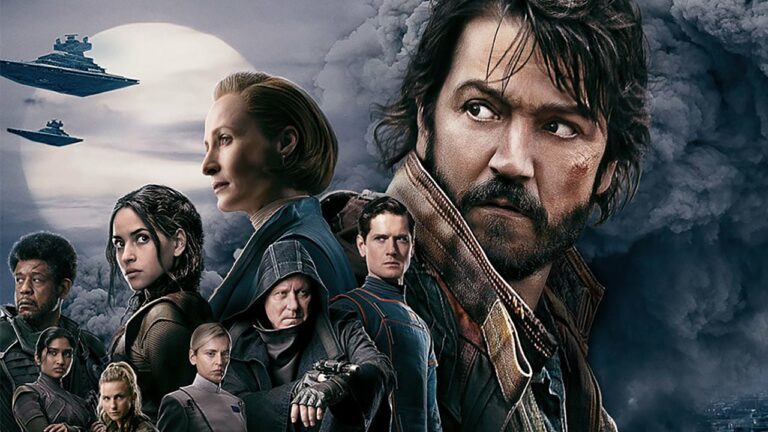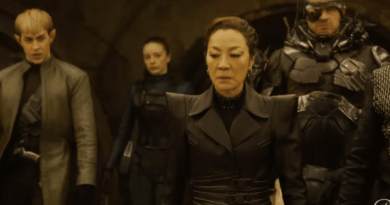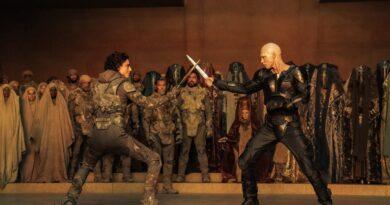
Andor Review
Article by Kieran Burt.
Andor has finally landed on Disney+, and it’s shaping up to be the darkest Star Wars project yet. Three episodes have been released on the service, and they all are majorly different from the other Star Wars series, and not just in their tone.
The tone is set by the very first scene of the first episode, with Cassian looking for his sister, which brings him to a brothel on the corporate planet of Morlana One, bumping heads with the local corporate guards. When they try to harass him in the dimly lit streets, Andor accidentally kills one in self-defence, reducing the other to beg on his knees. Andor kills him in cold blood. The dark setting and tone, the unnecessary loss of life, the tense music, all feature here, and are prominent in the rest of what’s shown.
This first scene sets up the main theme that the first three will explore, the cost of life. No one in Andor wears a helmet or a mask, and that’s purposeful. It gives the audience a chance to look beyond the armour that’s being worn, and see the pain that’s being caused. Linking to this is that no one is a hero, all the characters have redeeming and negative qualities (except B2EMO, he’s perfect – B2EMO spin off anyone?). Andor is far from the hero that audiences know. He kills in cold blood, lies to people, and is disrespectful, qualities usually found in the villain. Diego Luna shows audiences a new side to Cassian, one not bound by the morality of a hero.
This tense tone is present in all three episodes. There is a layer of suspense hanging over all of the characters actions, no one is quite sure who to fully trust or who to confide in, perfectly helped by Nicholas Britell’s score. This is captured by Bix and her relationship to Timm, her partner. Timm is very uneasy about what Bix does with Andor, but Bix likewise keeps him in the dark. If they both had communicated their feelings, Timm wouldn’t have called the authorities to Ferrix, nor would have gotten himself killed.
These three episodes are very light on action, preferring instead to focus on the drama and aforementioned suspense that comes from that. The third episode is the most action heavy, as the Preox-Morlana corporate security catch up with Andor. But it’s the wise choice to avoid the cookie-cutter action that helps to set Andor apart from past Star Wars series, and even when it goes into action, there isn’t a celebration of defeating the enemy – the last shot of it the audience sees is Syril Karn weeping over the death of his men. It ties into the idea of life being an important thing.
Syril Karn himself is the most interesting character presented so far. Kyle Soller plays an overly ambitious Deputy Inspector at Preox-Morlana. While he’s trying to do the right thing by investigating the murder of his fellow colleagues, his inexperience means that he’s out of his depth. He ignores his superior and his attempt at delivering a battle speech betrays his inexperience in the field by being full of trite cliches. Karn has given everything to his job, and doesn’t care who he has to step on to complete it, as shown by his horrific treatment of Maarv. The death of his men will likely only harden his resolve to find Cassian, drawing more casualties into the fight.
Andor also makes some very interesting lore introductions. The Empire are yet to show up in any capacity, though they have been mentioned twice, first by the head Inspector and then by Sergeant Mosk. But what they say helps to explain where the Preox-Morlana security forces fit in within the overall canon, and their relationship with the Empire. The head Inspector explains he is off to an Imperial meeting to give his report on crime rates, and he explains the best way to do it is with brevity. He isn’t a fan of the Empire, showing an uneasy partnership. Mosk has a much more positive view of the Empire, viewing the corporate force as a first line of defence. These two lines help give a brief insight into how the Corporate police force interacts with the Empire. Another aspect Andor handles is retconning. Previous Star Wars material has indicated Andor came from the planet Fest, though here it’s switched to Kenari, though it’s changed in a delicate manner that acknowledges the planet.
Speaking of Andor’s home, all three episodes contain flashbacks. These are weaved well throughout the show, explaining that a Republic ship crashed on Kenari, and while Cassian and a group of his tribe were exploring it, one of the members shot a member of the group. Cassian was then rescued by Maarv, who took him in as an adopted son. These flashbacks keep with the suspenseful tone of the main plotline, and reveal just enough to get audiences intrigued, but not enough to give the mystery of this planet away.
Though Andor is a much gritter take on the Star Wars world, it doesn’t mean it’s devoid of laughs. Both the first and second episode have a brief moment of humour, and they both serve to illustrate character. Most importantly, neither impact the overall tone of the show, not pulling the audience out.
Andor’s first three episodes have been a successful debut, keeping to the overall spy-thriller tone that has been teased in the trailer. It commits to a more dramatic and tense style of storytelling, making sure to separate itself from other Star Wars properties, but delivers a tale the galaxy sorley needs. It’s a more human take on the galaxy, making sure to dwell on the deaths and their tragedy, but balances this while expanding on the lore in an interesting way.



